In September in 2005 we went with a group of Euro-Toque Chefs to Italy on a cooks tour.
The undoubted highlight of the trip was our night in Massimo’s home.
I blogged this when I came home and I think the description of that night deserves a second airing.
It was, I think, my most memorable dinner of all time.
Grazie Massimo.
——————————————————————————————
September 22nd 2005
Massimo’s Casalinga
I’m just back from a marvellous trip which Sile and I and 26 other Irish chefs made to Italy.
I had met Massimo Spigaroli before, as a representative of Italy at meetings of Euro- Toques International in Brussels and lately in Spain.
I had assumed that, like the rest of us, Massimo was a chef in some smart upmarket restaurant in his home town.
When we planned our trip this autumn to Italy it was Massimo who did a lot of the work on the Italian side, organising our trips to producers of Parma Ham, Mortadella, Parmesan Cheeses and Balsamic Vinegar, helping us to book our meals in Parma and even lunch in the restaurant of one of our founder members, the much starred Gualtiero Marchesi (all of whom I will be writing about later).
There was also to be a trip to Massimo’s own restaurant (Al Cavalina Bianca) where he hoped to talk to us about his speciality, Culatello, and introduce us to his black pigs.
One of our company, Brid Torrades (co-inventor of the famous Scallops Torrades!)
had been in Massimo’s previously and strongly indicated that we were in for a pleasant surprise.
We were.
We got to Massimo’s restaurant, which was a beautiful but simple Italian Albergo beside the River Po, later than the 6.00 we were due so he rushed us off to a spotless cellar to show us how he made a Culatello “We must hurry or it will be too dark to see my pigs” (It was immediately obvious how important these animals were in Massimo’s life).
The Culatello, turned out to be a type of “Immagliature”(meaning tied with string.)
In this particular type the best parts of a leg of one of Massimo’s black pigs,
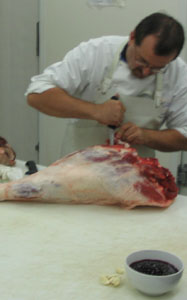
boned and seasoned with salt, pepper, garlic and Fortana wine,
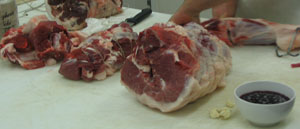
were tied in string, encased in a pigs bladder, then again skilfully tied with string
is left to hang and cure in certain particular conditions (of which more later) for a year or more before being sliced paper thin and eaten. Massimo referred to it as the “Truffle” of the Po Valley.
Even while Massimo’s fingers were flying skilfully over the pork, tying and knotting, he was apologising that tonight his restaurant was closed so he was so sorry that he couldn’t feed us there, instead we would have to eat in his own home, and that this was not finished yet, so we would have to crawl through the scaffolding to get in, and that they had no cookers there so they would have to roast in the bread ovens by the fire;
“Just simple food” he said, “a la casalinga”.(home cooking)

With the Culatello successfully wrapped we were back in the bus and off to see the farm where some of the black pigs were inside, but then off again, (and by now it was dark) to see the lads in the fields.
Having trudged through several hundred yards of stony muddy track
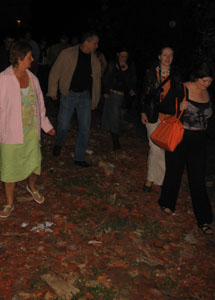
we eventually found them, well we vaguely saw them and heard them as they snuffled up to greet Massimo. Big beautiful shiny black pigs noisily stripping the ears of an acre of sweet corn.
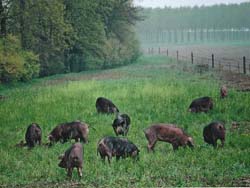
The pigs by day from Massimo’s site
“No need for the bus now” says the hardy Massimo, “its just Due Passe” (literally two steps read ½ mile) “to the house”.
As we got up to the house, a huge flock of geese honked around us

and we began to realise from the size alone (it was still encased in scaffolding and polythene) that this wasn’t a simple farm building.
In other words for Casa read Castle.
Massimo brought us through the scaffolding into the cellar where he had thousands of Culatelli hanging.
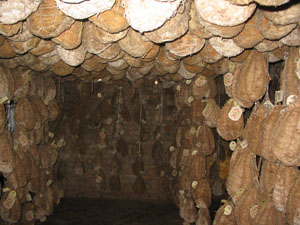
There was a strong smell of , shall we say, penicillin in the cellar and Massimo explained that, unlike Parma Ham which dried in the sweet dry mountain air, the Culatello needed the foggy air which coming in from the Po which flowed just outside.
Consequently they had large windows open to the river. The old stones of the (13th century) cellar had always been a factor in the “Cure” and they had discovered that they were naturally rich in Saltpetre which provided the Nitrates which kept the ham pink.
He then led us out of the rather smelly cellar into the kitchens and one of the most impressive “Coups de Theatre” I have ever experienced.
The kitchen was entirely lit with candles.

Huge rustic candelabra and equally huge wagon wheel chandeliers all glowing with hundreds of candles and giving the whole room a wonderful golden glow.
In one of the corners Mama and another two old ladies were busy rolling and making Pasta

and turning these into Ravioli and little Tortellini al Brodo for our supper.
On another side was a giant table groaning under a mountain of tarts, cakes and puddings.
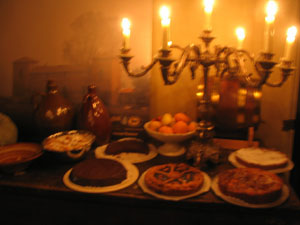
Across the floor was the bread oven in which were sizzling the shoulders of pork and the roast potatoes for our “simple” supper.
Massimo of course knew exactly what he was doing.
He was standing in one corner, his arm around Mama, his face wreathed in smiles as he saw the entranced and incredulous Irish stagger from one delight to another.
He then told us that he had been planning this moment since last Spring when Ruth, our secretary general, and I had said that we were planning to come to Italy in September.
He said that this was the first he had invited people into his house which was in fact the local castle which he and his family had bought recently and were busy renovating and turning into a Relais style hotel.
The rooms where we were to dine were even more impressive than the kitchen.
Here they had cleverly vaulted the high ceilings with wooden beams and in the Cartouches between had painted Trompe l’Oeiles of Roman Gods and Goddesses at play. (We were, after all in Italy.)
Everywhere was lit only by banks of candles, the dining tables lit by more wheels ascending upwards to the painted ceilings.
Massimo then directed us to a room between the dining areas; “to have a little Aperetivo and some Antipasti”
There the fully formally clad but extremely friendly waiters were serving delicious sparkling white wines, the bottles resting in ice in huge silver urns, and another band of waiters were busy slicing salami, and various hot and cold cured meats, and fresh Parmigiano for us.
One , extremely level headed catering manager for a large chain of Irish restaurants said to me “I have died and gone to heaven haven’t I?”
It was one hundred percent, carefully staged magic. I will never forget those moments.
It didn’t of course stop there.
After we had had our fill of Aperitivo we were ushered into the dining rooms.
Then Massimo made a triumphant procession with the Culatelli,
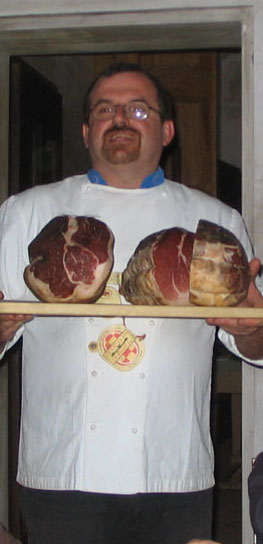
which then were sliced and served by the waiters.
First we were served a 10 month version of the cured meat which was much darker and more strongly flavoured than the Parma ham we had eaten the night before.
It was thoroughly delicious.
The next sampling, a twenty two month old ham was intensely porcine and had that interesting fungal whiff one gets from wild mushrooms.
Also delicious but a bit of an acquired taste for some of the Irish.
After this Mama, who was everything one could possibly want an Italian Mama to be,came to talk to us.
Did we have enough of everything ? Don’t forget to leave some space for the desserts, they were her speciality. When someone groaned that they were full already she said there were just two “piccolo” courses before the meat.
During all these courses we were drinking their own Fortana wine.
This sparkling red was not strictly speaking a wine at all, the charming wine waiter told us, as it had only 6 degrees of alcohol.
Therefore they poured it into tumblers rather than wine glasses.
I considered that carte blanche to drink loads, the waiters were more than happy to help.
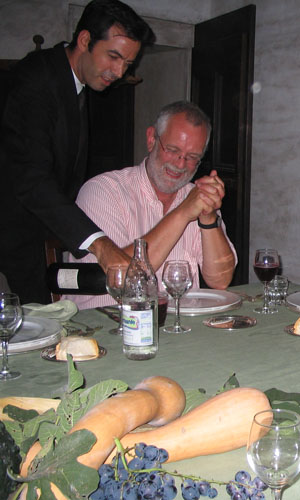
We ate next an unctuous plateful of ravioli stuffed with Ricotta and an interesting green picked from the ditches around the castle called “Erbetto Medico”.
(I think this was a type of Swiss Chard)
Then we had the little Tortelini in Brodo, tiny rounds of pasta stuffed with parmesan and served in broth, and at that stage even the bottomless pit known as the Dwyer stomach was incapable of fitting in another crumb.
(Bear in mind that we now have only finished the starters)
I did not do justice to the roast pork or, and (for this fault I am truly sorry Mama!)
only managed to taste a delicate lime and lemon “Sorbetto” from her groaning board.
And then it was over.
It was up to me to make the speech of thank you to Massimo.

Massimo, Mama, Brid Torrades, Ruth (translating) and the inadequate speechifier
I was shamefully inadequate, but, as you can see, we had brought him a bottle of Redbreast Whiskey.
Mama went one better and insisted on giving each of us a goodie bag with a bottle of Fontana and a Strolghino salami made from Culatello meat as we left.
Massimo is certainly one of the most impressive (and pleasant) people I have met in the industry.He is such an inspiration to the students in Alma College that one of them told us that if they get depressed they only have to stand near him to get re-inspired!
An evening not just to remember but to treasure.

Comments
The comments are closed.